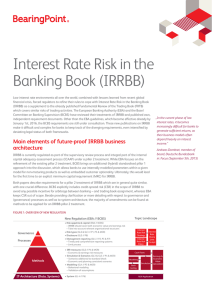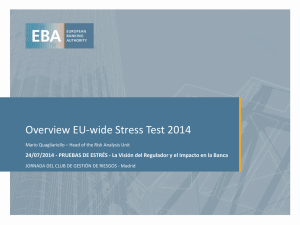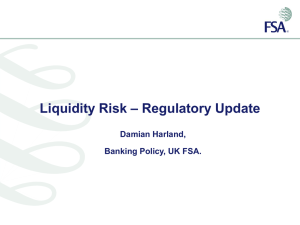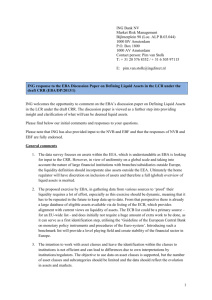Press release - European Banking Authority
advertisement
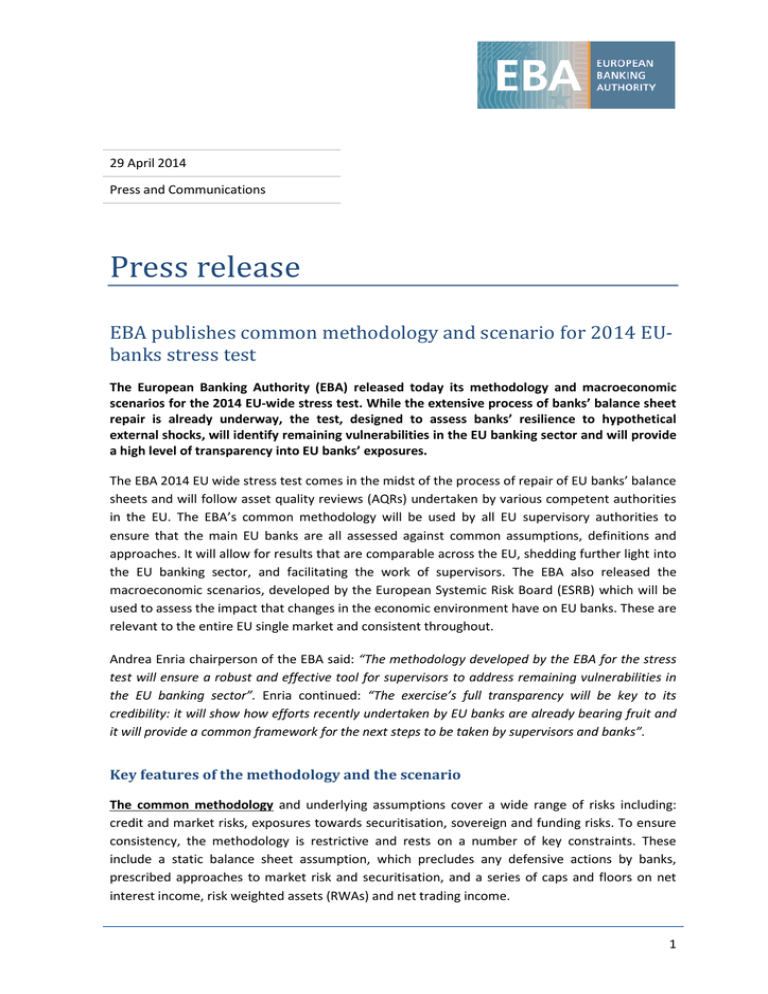
29 April 2014 Press and Communications Press release EBA publishes common methodology and scenario for 2014 EUbanks stress test The European Banking Authority (EBA) released today its methodology and macroeconomic scenarios for the 2014 EU-wide stress test. While the extensive process of banks’ balance sheet repair is already underway, the test, designed to assess banks’ resilience to hypothetical external shocks, will identify remaining vulnerabilities in the EU banking sector and will provide a high level of transparency into EU banks’ exposures. The EBA 2014 EU wide stress test comes in the midst of the process of repair of EU banks’ balance sheets and will follow asset quality reviews (AQRs) undertaken by various competent authorities in the EU. The EBA’s common methodology will be used by all EU supervisory authorities to ensure that the main EU banks are all assessed against common assumptions, definitions and approaches. It will allow for results that are comparable across the EU, shedding further light into the EU banking sector, and facilitating the work of supervisors. The EBA also released the macroeconomic scenarios, developed by the European Systemic Risk Board (ESRB) which will be used to assess the impact that changes in the economic environment have on EU banks. These are relevant to the entire EU single market and consistent throughout. Andrea Enria chairperson of the EBA said: “The methodology developed by the EBA for the stress test will ensure a robust and effective tool for supervisors to address remaining vulnerabilities in the EU banking sector”. Enria continued: “The exercise’s full transparency will be key to its credibility: it will show how efforts recently undertaken by EU banks are already bearing fruit and it will provide a common framework for the next steps to be taken by supervisors and banks”. Key features of the methodology and the scenario The common methodology and underlying assumptions cover a wide range of risks including: credit and market risks, exposures towards securitisation, sovereign and funding risks. To ensure consistency, the methodology is restrictive and rests on a number of key constraints. These include a static balance sheet assumption, which precludes any defensive actions by banks, prescribed approaches to market risk and securitisation, and a series of caps and floors on net interest income, risk weighted assets (RWAs) and net trading income. 1 Other key methodological components are: (i) a sovereign shock that impacts banks entire balance sheet including exposures held in the available for sale portfolio (AFS) via the internationally agreed gradual phase-out of prudential filters, (ii) a shock to banks funding costs that pass-through to the asset and liability side in a conservative asymmetric fashion. The adverse scenario, designed by the ESRB, reflects the systemic risks that are currently assessed as representing the most pertinent threats to the stability of the EU banking sector: (i) an increase in global bond yields amplified by an abrupt reversal in risk assessment, especially towards emerging market economies; (ii) a further deterioration of credit quality in countries with feeble demand; (iii) stalling policy reforms jeopardising confidence in the sustainability of public finances; and (iv) the lack of necessary bank balance sheet repair to maintain affordable market funding. The negative impact of the shocks, which include also stress in the commercial real estate sector, as well as a foreign exchange shock in Central and Eastern Europe, is substantially global. In the EU, the scenario leads overall to a cumulative deviation of EU GDP from its baseline level by -2.2% in 2014, by -5.6% in 2015, and -7.0% in 2016. The EU unemployment is higher than its baseline level, by 0.6 percentage points in 2014, by 1.9 percentage points in 2015 and by 2.9 percentage points in 2016. For most advanced economies, including Japan and the US, the scenario results in a negative response of GDP ranging between 5-6 per cent in cumulative terms compared to the baseline. Process The EU-wide stress test will be conducted on a sample of 124 EU banks which cover at least 50% of each national banking sector, and will be run at the highest level of consolidation. The running of the exercise will involve close cooperation between the EBA and the Competent Authorities at national level (CAs), including the European Central Bank (ECB). The EBA will be responsible for coordinating the exercise in cooperation with the ECB (in case of Single Supervisory Mechanism SSM countries) and ensuring effective cooperation between home and host supervisors. Most importantly, the EBA will act as a data hub for the extensive transparency of the results of the common exercise. On the other hand, CAs will bear responsibility for overseeing the exercise with the banks, checking the quality of the results and identifying and implementing any necessary supervisory reaction measure. 2
